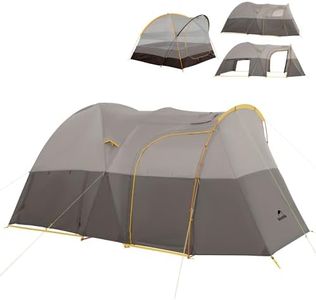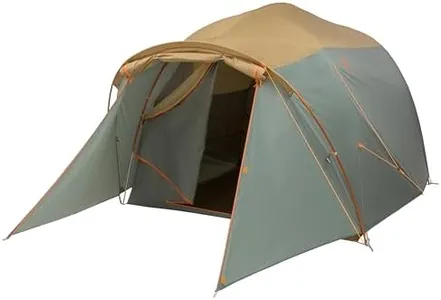10 Best Tents 2026 in the United States
Our technology thoroughly searches through the online shopping world, reviewing hundreds of sites. We then process and analyze this information, updating in real-time to bring you the latest top-rated products. This way, you always get the best and most current options available.

Our Top Picks
Winner
OneTigris Stella 4 Season Camping Tent Backpacking 2 Person Waterproof Lightweight Easy Setup Instant 3000mm Waterproof Rating Outdoor Hiking Tent, Black
Most important from
353 reviews
The OneTigris Stella is a lightweight, 2-person camping tent designed for 4-season use, making it a solid choice if you need a reliable shelter throughout the year. Weighing just 4.4 pounds (2 kg), it's easy to carry on hiking or backpacking trips without adding much bulk. Its compact packed size (about 20 x 6 inches) fits well in most backpacks. The tent is made from durable nylon with a 3000mm waterproof rating, so it can handle heavy rain and keep you dry. It also includes a removable blackout outer layer, which is great if you want to block light or increase privacy.
Ventilation is decent thanks to a mesh inner tent that allows airflow while keeping bugs out, helping reduce condensation inside. Setup is straightforward using flexible poles that cross at the top and secure at four corners, which should be manageable even if you’re new to pitching tents. The floor space is enough for two people with some gear, and the dome shape provides a bit of headroom. Some users may find it has just one door, which could be less convenient for two people.
This tent performs well in various weather, though very strong winds or snow might challenge this lightweight design. It is well suited for backpackers, campers, or hikers who want a durable, waterproof shelter that’s easy to carry and set up, especially if you plan to camp in all seasons but do not need extra space or very complex features.
Most important from
353 reviews
Big Agnes Copper Spur HV UL - Ultralight Backpacking Tent, Olive Green, 2 Person
Most important from
328 reviews
The Big Agnes Copper Spur HV UL 2-person tent is a solid choice for backpackers wanting a lightweight but well-equipped shelter for three-season use. It weighs just 1.37 kg (around 3 lbs), making it easy to carry on long hikes without adding unnecessary bulk. The tent’s two doors and vestibules add convenience, allowing easy access and extra covered storage space for gear. Its innovative TipLok buckles simplify setup and increase stability, which is helpful if you want to spend less time pitching your tent.
The fabric is strong yet light, with a waterproof rating of 1200 mm, offering reliable protection against rain and light snow, though it may not handle heavy downpours or winter storms. Ventilation is addressed with mesh panels and the design helps reduce condensation, but like many ultralight tents, airflow might be somewhat limited in very humid conditions. Inside, it offers smart storage options like overhead pockets and a raised foot-area container, which keep gear organized and away from the floor.
The tent’s dimensions provide a comfortable sleeping area for two people, though taller campers might find the length a bit tight. The packed size is compact, making it easy to fit in a backpack. While the price can be higher than basic tents, this model appeals to trekkers and campers who value a blend of durability, lightness, and thoughtful features for moderate weather. It may not be ideal for harsh winter or very windy conditions, but for typical spring to fall adventures, it performs well.
Most important from
328 reviews
CORE 12 Person Instant Cabin Tent | Large 3 Room Family Pop Up Tent for 2 Minute Camp Setup | Included Storage Pockets for Camping Accessories
Most important from
3511 reviews
The CORE 12 Person Instant Cabin Tent is an excellent choice for large groups or families seeking a spacious and easy-to-setup camping tent. With a generous capacity, it fits up to 12 people without gear or comfortably accommodates 6 people with gear. The tent's instant pop-up technology allows for a quick 2-minute setup, making it highly convenient for users who prefer minimal hassle.
The tent's three-room capability, featuring two room dividers, provides added privacy, which is a significant benefit for families or mixed groups. Storage pockets inside the tent keep essentials organized and off the floor, contributing to a clutter-free environment. Ventilation is well-handled with lower vents that bring in cool air and a mesh ceiling that allows hot air to escape, ensuring a comfortable indoor climate.
The H20 Block Technology, 1200mm water resistance, fully taped rainfly, and sealed seams, along with included guylines and steel stakes, offer reliable protection against weather elements. However, the tent is quite heavy at 47.8 pounds, which might be a drawback for those planning extended hikes or carrying it over long distances. Additionally, while it is water-resistant, it is not entirely waterproof, so extreme weather conditions might still pose a challenge. This tent is best suited for users who camp in fair weather conditions across spring, summer, and fall. The build quality and user-friendly design make it ideal for family camping trips, group outings, or anyone who values space, ease of setup, and good weather protection.
Most important from
3511 reviews
Buying Guide for the Best Tents
Choosing a tent can seem overwhelming, but breaking it down to your actual needs makes it much simpler. Think first about how you plan to use your tent: will you camp alone or with others, in summer or throughout the year, hiking far from your car or camping nearby? Asking yourself these questions can help you focus on the features that really matter to your comfort and safety. Below are the main specifications to consider, with explanations to help you navigate your options and decide what fits you best.FAQ
Most Popular Categories Right Now





















